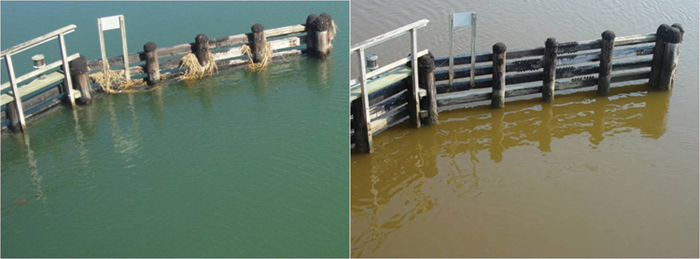The year 2011 has been a banner one for the single-celled alga
Aureococcus anophagefferens whose prolific blooms are known as “brown tide.” With concentrations in excess of 2 million cells per milliliter in some Long Island bays, this alga turned the waters brown from western Shinnecock Bay to eastern Moriches Bay, making for intense, though localized, brown tide conditions.
While not harmful to humans, concentrated brown tide blooms make it difficult for bivalves to feed and can kill juvenile clams and scallops. “This marks the fifth consecutive year of a bloom of over 1 million cells per milliliter in this particular area,” said
Dr. Christopher Gobler of the School of Marine and Atmospheric Sciences at Stony Brook University.
Dr. Gobler keeps a close watch on brown tide— from the color of the water right down to its DNA sequence. In the February 21 online
Proceedings of the National Academy of Sciences, he and his research team announced a “first.” They had sequenced and annotated the first complete genome of a harmful algal bloom species,
Aureococcus anophagefferens.
 Brown tide lives up to its name. Quantuck Bay on eastern Long Island under normal conditions (left)
Brown tide lives up to its name. Quantuck Bay on eastern Long Island under normal conditions (left)
and under brown tide conditions when the brown tide alga dominates. Photos by Dr. Christopher Gobler
“
Aureococcus has contributed to major declines in the Long Island shellfish industry over the past 25 years,” said
Dr. Jim Ammerman, Director of New York Sea Grant. “For the past 15 years, Sea Grant has supported a number of Dr. Gobler’s ecological studies of
Aureococcus, several through the Brown Tide Research Initiative launched in 1996 and funded by NOAA’s Ecology and Oceanography of Harmful Algal Blooms program. More recently, we have directly funded Gobler’s brown tide genomic research which suggests that
Aureococcus is potentially well-adapted to exploit current coastal conditions of increased turbidity, metals, and organic compounds.”
The 56-million base pair
Aureococcus genome was sequenced in 2007 by the Department of Energy’s Joint Genome Institute from a culture isolated from the shores of Long Island, one of the regions most affected by the alga since it first appeared in 1985 along the east coast. Gobler’s team then analyzed what the sequence means. “Compared to other phytoplankton inhabiting the same estuaries,
Aureococcus, which outcompetes them, shows several genome-encoded advantages” says Gobler. For example, the genomic study revealed that
Aureococcus had 62 light-harvesting genes whereas its competitors had a couple of dozen of these genes on average, making this microalga well-adapted to low light or even no-light conditions. “
Aureococcus also produces a large number of enzymes which rely on metals and can use organic compounds that are abundant in shallow estuaries,” notes Gobler. Chalk up two more genetic advantages.
The study provides a greater understanding of this microalga and how the information can be used to protect our waters. “We now know that this organism is genetically predisposed to exploit certain characteristics of coastal ecosystems,” notes Dr. Gobler. “But we also know the characteristics are there because of human activities. If we continue to increase, for example, organic matter in coastal waters, then it’s going to continue to favor brown tides since it is genetically predisposed to thrive in these conditions. We believe the same genome-enabled approach used for this study can be applied to other harmful algal blooms in the future.”
— Barbara A. Branca and Paul C. Focazio